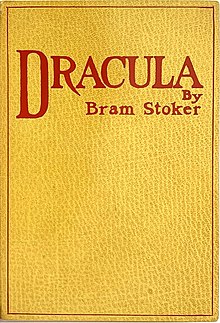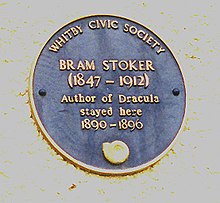Bram Stoker
Bram Stoker | |
|---|---|
| head and shoulders monochrome photo portrait of bearded Stoker in a suit | |
| Occupation | Novelist |
| Nationality | Irish |
| Genre | Horror, Romantic Fiction |
| Literary movement | Victorian |
Abraham "Bram" Stoker (8 November 1847 – 20 April 1912) was an Irish writer of novels and short stories, who is best known today for his 1897 horror novel Dracula. During his lifetime, he was better known for being the personal assistant of the actor Henry Irving and the business manager of the Lyceum Theatre in London, which Irving owned.
Early life
He was born in 1847 at 15 Marino Crescent,[1] located today in Fairview, but then in Clontarf, Dublin, Ireland. His parents were Abraham Stoker (1799-1876) and the feminist Charlotte Mathilda Blake Thornely (1818-1901). Stoker was the third of seven children.[2] Abraham and Charlotte were members of the Clontarf Church of Ireland parish and attended the parish church (St. John the Baptist located on Seafield Road West) with their children, who were both baptised there.
Stoker was bed-ridden until he started school at the age of seven, when he made a complete recovery. Of this time, Stoker wrote, "I was naturally thoughtful, and the leisure of long illness gave opportunity for many thoughts which were fruitful according to their kind in later years."
After his recovery, he became a normal young man, even excelling as an athlete (he was named University Athlete) at Trinity College, Dublin , which he attended from 1864 to 1870. He graduated with honours in mathematics. He was auditor of the College Historical Society and president of the University Philosophical Society, where his first paper was on "Sensationalism in Fiction and Society".
Early career
In 1876, while employed as a civil servant in Dublin, Stoker wrote a non-fiction book (The Duties of Clerks of Petty Sessions in Ireland, published 1879) and became the theatre critic for the newspaper Dublin Evening Mail. In December 1876, he gave a favourable review of the actor Henry Irving's performance as Hamlet at the Theatre Royal in Dublin. Irving read the review and invited Stoker for dinner at the Shelbourne Hotel, where he was staying. After that they became friends. He also wrote stories, and in 1872 "The Crystal Cup" was published by the London Society, followed by "The Chain of Destiny" in four parts in The Shamrock.

Lyceum Theatre and later career
In 1878 Stoker married Florence Balcombe, a celebrated beauty whose former suitor was Oscar Wilde. The couple moved to London, where Stoker became acting-manager and then business manager of Irving's Lyceum Theatre, a post he held for 27 years. On 31 December 1879, Bram and Florence's only child was born, a son that they christened Irving Noel Thornley Stoker. The collaboration with Irving was very important for Stoker and through him he became involved in London's high society, where he met, among other notables, James McNeil Whistler and Sir Arthur Conan Doyle (to whom he was distantly related). In the course of Irving's tours, Stoker got the chance to travel around the world. In the mid 1890s, Stoker is rumoured to have become a member of the Hermetic Order of the Golden Dawn, though there is no concrete evidence to support this claim.[3][4] One of Stoker's closest friends was J.W. Brodie-Innis, a major figure in the Order, and Stoker himself hired Pamela Coleman Smith, as an artist at the Lyceum Theater.

Stoker supplemented his income by writing novels; the best known being the vampire tale Dracula which was published in 1897. While preparing Dracula, researched European folklore and earlier stories of vampires. Dracula is an epistolary novel, written as collection of diary entries, telegrams, and letters from the characters, as well as fictional clippings from the Whitby and London newspapers. A major inspiration for the story was the town of Whitby. Other inspirations may have included a visit to Slains Castle in Aberdeenshire, and a visit to the crypts under the church St. John the Baptist where Stoker was baptised.
Death
Bram Stoker died of tertiary syphilis at No 26 St George's Square in 1912[5] and was cremated and his ashes placed in a display urn at Golders Green Crematorium. After Irving Noel Stoker's death in 1961, his ashes were added to that urn. The original plan had been to keep his parents' ashes together, but after Florence Stoker's death her ashes were scattered at the Gardens of Rest.
Posthumous
The short story collection Dracula's Guest and Other Weird Stories was published in 1914 by Stoker's widow Florence Stoker. The first film adaptation of Dracula was named Nosferatu. It was directed by Friedrich Wilhelm Murnau and starred Max Schreck as Count Orlock. Nosferatu was produced while Florence Stoker, Bram Stoker's widow and literary executrix, was still alive. Represented by the attorneys of the British Incorporated Society of Authors, she eventually sued the filmmakers. Her chief legal complaint was that she had been neither asked for permission for the adaptation nor paid any royalty. The case dragged on for some years, with Mrs. Stoker demanding the destruction of the negative and all prints of the film. The suit was finally resolved in the widow's favour in July 1925. Some copies of the film survived, however and the film has become well known.
Bibliography
Novels

- The Primrose Path (1875)
- The Snake's Pass (1890)
- The Watter's Mou' (1895)
- The Shoulder of Shasta (1895)
- Dracula (1897)[1]
- Miss Betty (1898)
- The Mystery of the Sea (1902)
- The Jewel of Seven Stars (1903)
- The Man (aka: The Gates of Life) (1905)
- Lady Athlyne (1908)
- The Lady of the Shroud (1909)
- The Lair of the White Worm (1911)
Short story collections
- Under the Sunset (1881), comprising eight fairy tales for children
- Snowbound: The Record of a Theatrical Touring Party (1908)
- Dracula's Guest and Other Weird Stories (1914), published posthumously by Florence Stoker
Uncollected stories
- "Bridal of Dead" (alternate ending to The Jewel of Seven Stars)
- "Buried Treasures"
- "The Chain of Destiny"
- "The Crystal Cup"
- "The Dualitists; or, The Death Doom of the Double Born"
- "Lord Castleton Explains" (chapter 10 of The Fate of Fenella)
- "The Gombeen Man" (chapter 3 of The Snake's Pass)
- "In the Valley of the Shadow"
- "The Man from Shorrox"
- "Midnight Tales"
- "The Red Stockade"
- "The Seer" (chapters 1 and 2 of The Mystery of the Sea)
Non-fiction
- The Duties of Clerks of Petty Sessions in Ireland (1879)
- A Glimpse of America (1886)
- Personal Reminiscences of Henry Irving (1906)
- Famous Impostors (1910)
- Bram Stoker's Notes for Dracula: A Facsimile Edition (2008) Bram Stoker Annotated and Transcribed by Robert Eighteen-Bisang and Elizabeth Miller, Foreword by Michael Barsanti. Toronto: McFarland. ISBN 978-0-7864-3410-7
Critical Works on Stoker
- William Hughes, Beyond Dracula (Palgrave, 2000) ISBN 0312231369 [6]
References and notes
- ^ Belford, Barbara (2002). Bram Stoker and the Man Who Was Dracula. Cambridge, Mass.: Da Capo Press. p. 17. ISBN 0-306-81098-0.
- ^ His siblings were: Sir (William) Thornley Stoker, born in 1845; Mathilda, born 1846; Thomas, born 1850; Richard, born 1852; Margaret, born 1854; and George, born 1855
- ^ Ravenscroft, Trevor (1982). The occult power behind the spear which pierced the side of Christ. Red Wheel. pp. p165. ISBN 0877285470.
{{cite book}}:|pages=has extra text (help) - ^ Picknett, Lynn (2004). The Templar Revelation: Secret Guardians of the True Identity of Christ. Simon and Schuster. pp. p201. ISBN 0743273257.
{{cite book}}:|pages=has extra text (help) - ^ Gibson, Peter (1985). The Capital Companion. Webb & Bower. pp. 365–366. ISBN 0863500420.
{{cite book}}: Cite has empty unknown parameter:|coauthors=(help) - ^ http://muse.jhu.edu/login?uri=/journals/victorian_studies/v044/44.2glover.html
External links
- Bram Stoker at Curlie
- Bram Stoker at IMDb
- Template:Find A Grave
- h2g2 article on Bram Stoker
- Bram Stoker's brief biography and works
- 20 Common Misconceptions and Other Miscellaneous Information
- The Stoker Dracula Organisation
- Gothic and Stoker Studies at Bath Spa University [2]
